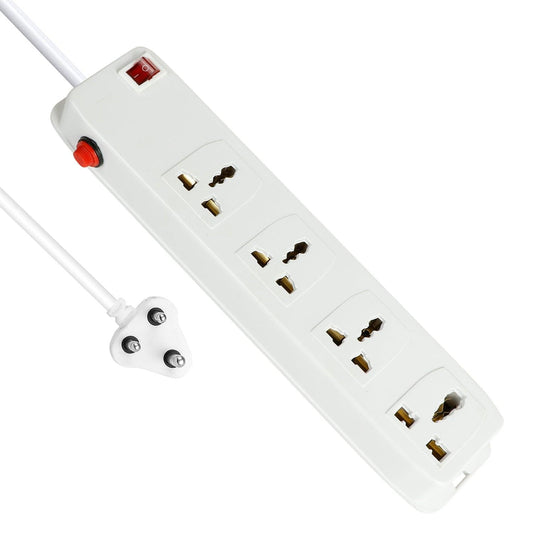Filter
7 results
20
- 10
- 15
- 20
- 25
- 30
- 50
Best selling
- Featured
- Best selling
- Alphabetically, A-Z
- Alphabetically, Z-A
- Price, low to high
- Price, high to low
- Date, old to new
- Date, new to old
Sort
Sort by:
- Featured
- Best selling
- Alphabetically, A-Z
- Alphabetically, Z-A
- Price, low to high
- Price, high to low
- Date, old to new
- Date, new to old
-
FEDUS extension-cords, Long Extension Board Extension Box | Spike Guard 6 Socket 6 Switch Junction Box with Switch, Extension Cords Cord, Spike Buster, Extension Board
SOCKET TYPE - 6+6 power strip which comes with 6 international sockets & 6 Master LED switch, which is suitable for different types of plugs used over 180 countries including US, UK, Germany, Australia, NZ, Japan, China, India, and Others HEAVY-DUTY SOCKET - Compatible...- from ₹. 719.00
- from ₹. 719.00
- Unit price
- / per
-
FEDUS Extension Boards, Long Wire Switch Board Extension | Extension Boards with Switch,Extension Board with Long Wire, Extension Board for Computer, Surge Protectors Spike Buster, Switch Board
▶SOCKET TYPE - 4+4 power strip which comes with 4 international sockets & 4 Master LED switch, which is suitable for different types of plugs used over 180 countries including India, US, UK, Germany, Australia, NZ, Japan, China, and Others ▶HEAVY-DUTY SOCKET - Compatible...- from ₹. 699.00
- from ₹. 699.00
- Unit price
- / per
-
FEDUS Extension Board With 2 Output USB Charging Ports(2.1A ) 4 Universal Power Sockets, Switch Board Extension Board Cord, Power Strip, 3-Pin Surge Protection for Home Office
▶POWER STRIP WITH USB: 4 Special design widely spacing AC outlets (Max load of 10A) and 2 USB ports total 2.4amp. 1 Master switch, Built- with smart technology, detecting charging devices and deliver optimal charging speed automatically, enable you to power up 6 devices...- from ₹. 693.19
- from ₹. 693.19
- Unit price
- / per
-
FEDUS Switch Board Extension,Extension Boards with Switch, Extension Cords, Extension Board with Long Wire, Extension Board for Computer, Surge Protectors Spike Buster, Switch Board Organizer 4M/13F
SOCKET TYPE - 4+4 power strip which comes with 4 international sockets & 4 Master LED switch, which is suitable for different types of plugs used over 180 countries including US, UK, Germany, Australia, NZ, Japan, China, India, and Others HEAVY-DUTY SOCKET - Compatible...- ₹. 599.00
- ₹. 599.00
- Unit price
- / per
-
FEDUS Long Wire switch board extension|extension boards with switch,extension board with long wire,extension cords, extension board for computer,surge protectors spike buster,switch board
SOCKET TYPE - 4+1 power strip which comes with 4 international sockets & 1 Master LED switch, which is suitable for different types of plugs used over 180 countries including India, US, UK, Germany, Australia, NZ, Japan, China, and Others HEAVY-DUTY SOCKET - Compatible...- ₹. 499.00
- ₹. 499.00
- Unit price
- / per
-
FEDUS electric extension board, Switch Board Extension Cords with Long Wire for Computer, Surge Protectors Spike Buster
SOCKET TYPE - 4+4 power strip which comes with 4 international sockets & 4 Master LED switch, which is suitable for different types of plugs used over 180 countries including US, UK, Germany, Australia, NZ, Japan, China, India, and Others HEAVY-DUTY SOCKET - Compatible...- from ₹. 587.00
- from ₹. 587.00
- Unit price
- / per
-
FEDUS spike-buster, Surge Protectors Spike Buster Extension Boards with Switch and Long Wire for Computer (4M/13F)
SOCKET TYPE - 4+1 power strip which comes with 4 international sockets & 1 Master LED switch, which is suitable for different types of plugs used over 180 countries including US, UK, Germany, Australia, NZ, Japan, China, India, and Others HEAVY-DUTY SOCKET - Compatible...- ₹. 449.00
- ₹. 449.00
- Unit price
- / per



















